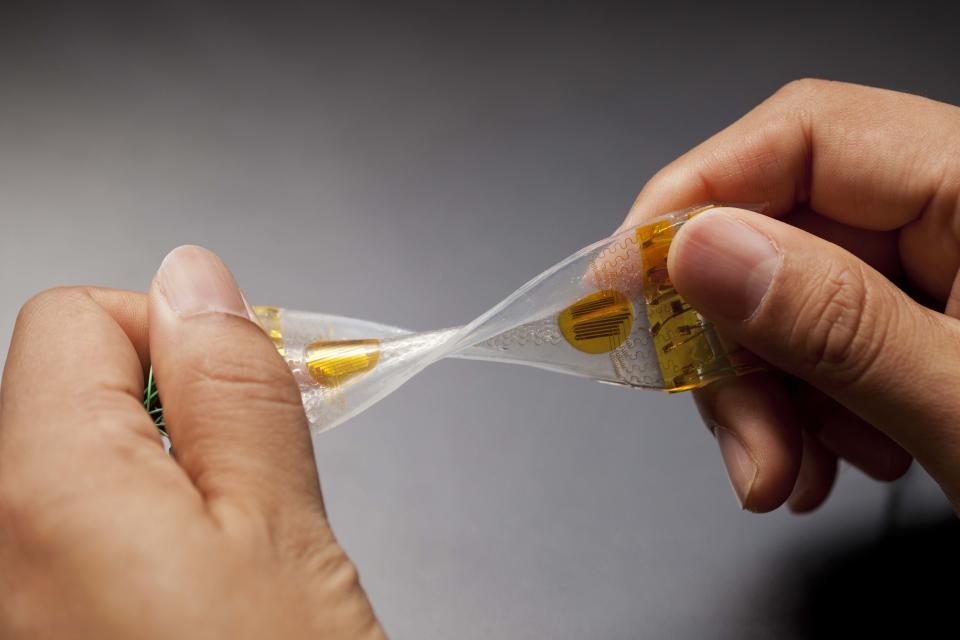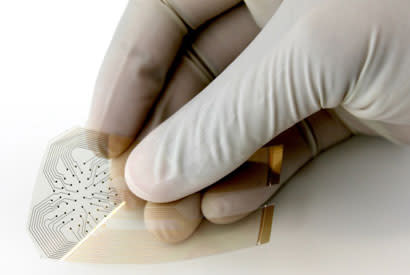Flexible Smart Sensors and the Future of Health

Have you heard of flexible bioelectronics? While it's doubtful the phrase will ever become a sexy buzzword, these next-gen wearable sensors just might save your life one day.
Researchers from some of the top educational institutions and the private sector have been developing lightweight, bendable sensors that take advantage of the latest biomaterials and microelectronics to create smart bandages, stamps and stickers that will give us new insights to improve our health and wellness.
Although the technology is still emerging, recent developments are promising.
Smart Bandages
Supported by the National Science Foundation (NSF), researchers from Harvard, Purdue, Tufts and Brigham and Women's Hospital have created smart bandages to monitor and treat wounds that require ongoing care, such as diabetic ulcers, bed sores and burns.

Reza Abdi, associate professor in medicine at Harvard, explained to LiveScience that, "We first create microparticles containing drug molecules and then incorporate these into a hydrogel patch that holds them. Next, we place a stimulation mechanism on top of the hydrogel patch. We monitor the wound area, such as its temperature and pH levels using flexible sensors. If the wound environment is outside normal conditions, then we send a pulse to the electrical stimulator which induces drug release from the microparticles."
Another team from UC Berkeley is creating a similar technology to detect tissue damage associated with bed sores before it progresses. It works by using a printed array of tiny electrodes on a thin flexible film to monitor for the electrical changes caused by cell death. Dr. Michael Harrison, professor of surgery at USCF said, "By the time you see signs of a bedsore on the surface of the skin, it's usually too late... If you can detect bedsores early on, the solution is easy. Just take the pressure off."
Smart bandages and similar sensors may still be five to ten years away from being used on patients, but they will eventually enable doctors and caregivers to monitor wounds in real-time by collecting valuable data, and to automatically remedy a condition, such as an infection, a drop in insulin, etc.
Mind and Body
Beyond the skin, flexible bioelectronics can be used to monitor brain activity and internal organs.

John Rogers, a materials scientist from the University of Illinois at Urbana Champaign, said, "Our prototypes can provide a variety of monitoring and stimulation functions. We can pick up coordinated firing of neurons, and run that activity through a computer spelling interface, so that brainwaves pick letters out of a virtual keyboard display and type messages."
The Biostamp patch developed by Rogers is as light as a feather, which lets wearers use it for long periods of time without annoyance. It aims to replace a helmet of electrodes (which isn't exactly portable and requires the wearer's head to be scrubbed), and offers better accuracy by collecting more information over longer periods of time. The patch further increases accuracy by eliminating background noise and using high-density electrodes that generate thousands of times more brain activity information.
By using the data generated by the wearable device, it can measure the brain waves associated with epileptic seizures and alert its wearer before a crisis occurs. It also aims to provide more insight into sleep patterns and disorders, which had previously been impossible.
Wearable patches have numerous additional use cases. For example, the team led by Rogers previously created electronic devices that were inserted into the pelvic nerve to reduce bladder dysfunction, and on the heart as an advanced pacemaker. Stamps can even dissolve safely inside the body after a period of time, reducing the risk of long-term complications. It's tantalizing to imagine a future where every organ can be monitored, to ensure any ailment is under control.
A Flexible Approach
As Moore's law has continued to hold true, more computing power is available on ever smaller, cheaper circuits. Flexible electronics, created through the most recent innovations in materials, have taken advantage of this fact. The Internet of Things (IoT) has completed the puzzle, by interconnecting devices and sensors in new ways to make data more accessible.
According to Rogers, "The history of electronics is about getting closer to the individual. At first it was a computer down the hall, followed by a desktop, then a laptop, a phone in your pocket and a watch on your wrist. Now it could be electronics integrated the skin, bioelectronics, and fully implantable devices."
Fitbit and the like are fun tools to monitor health and fitness, but these new devices have the potential to save and improve lives. When flexible bioelectronics are available to all, healthcare will take a giant step forward.
